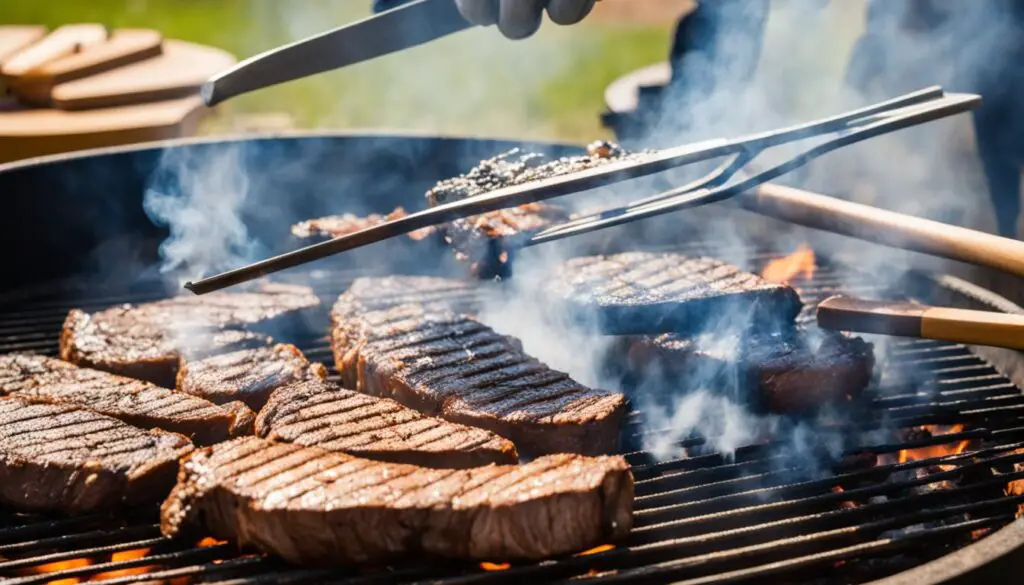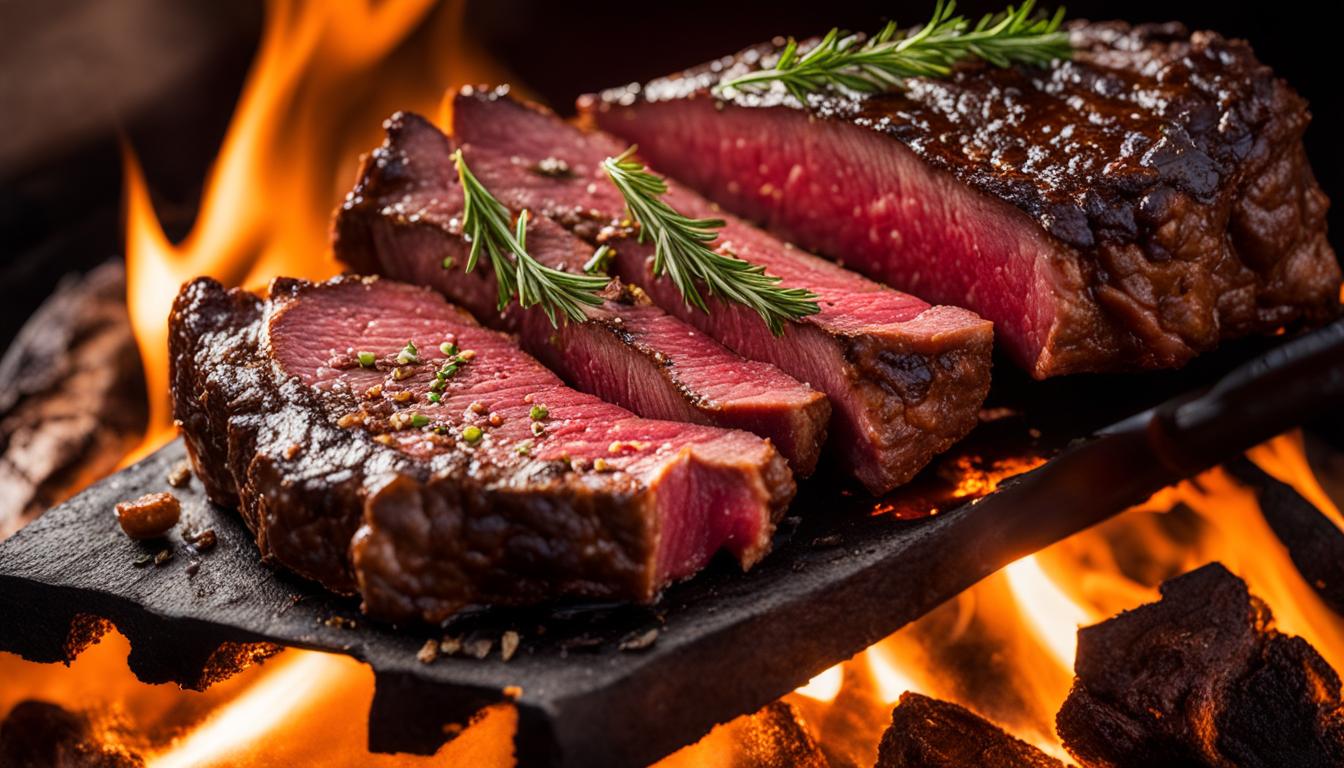In this article, we will explore the question of whether bison makes good steaks. Bison meat has gained popularity in recent years as a delicious alternative to beef, but does it live up to the hype? Let’s dive into the flavor and tenderness of bison meat compared to beef and discover why it might just be your new favorite steak option.
When it comes to flavor, bison meat offers a rich and robust taste that is similar to beef but with its own unique twist. The meat has a slightly sweeter and more savory flavor profile, making it a delightful choice for those looking to switch up their steak game. Whether you prefer your steaks cooked rare or well-done, bison meat retains its natural tenderness and juicy texture, ensuring a satisfying dining experience.
Key Takeaways:
- Bison meat is a tasty alternative to beef, offering a unique flavor profile.
- Bison steaks retain tenderness and juiciness, regardless of cooking preference.
- Exploring bison steaks can introduce new and exciting flavors to your meals.
- Consider bison as a delicious option for steak lovers looking for a change.
- Next, we will delve into the quality of bison steaks.
The Quality of Bison Steaks
When it comes to bison steaks, quality is the key to a truly exceptional dining experience. The unique characteristics of bison meat contribute to its reputation as one of the best alternatives to traditional beef steaks. Let’s explore what sets bison steaks apart and why they’re considered some of the finest cuts available.
Tenderness and Flavor
Bison meat is renowned for its tenderness and rich flavor profile. The quality of bison steaks can be attributed to several factors:
- Diet: Bison graze on natural grasses, resulting in leaner and more flavorful meat.
- Low Fat Content: Bison meat is significantly leaner than beef, enhancing the natural taste and preventing excessive juiciness.
- Marbling: While bison meat is generally lean, small amounts of marbling contribute to its tenderness and flavor.
- Aging: Proper aging of bison meat allows the flavors to develop and intensify, resulting in a more enjoyable dining experience.
These factors work together to create bison steaks that are succulent, tender, and bursting with natural flavors.
“The tenderness and flavor of bison steaks are truly remarkable. The grass-fed diet and natural aging process contribute to a dining experience that is second to none.”
Best Bison Steaks
While all bison steaks offer exceptional quality, certain cuts are particularly sought after for their tenderness and flavor. Here are some of the best bison steaks you should try:
| Bison Steak Cut | Description |
|---|---|
| Ribeye | A well-marbled and flavorful cut, the ribeye is prized for its tenderness and juiciness. |
| Filet Mignon | This lean, tender cut is melt-in-your-mouth perfection, offering a delicate yet intense flavor. |
| New York Strip | With its perfect balance of tenderness and rich beefy flavor, the New York strip is a popular choice among steak lovers. |
| Sirloin | The sirloin cut offers a great balance of tenderness and flavor, making it a versatile option for various recipes. |
These cuts are just a few examples of the best bison steaks available, each offering its own unique taste and texture.
Now that we’ve explored the quality and characteristics of bison steaks, it’s clear why they are considered some of the best cuts of meat for steak enthusiasts. In the next section, we will delve into the various techniques and tips for cooking bison steaks to perfection.
Cooking Bison Steaks: Tips and Techniques

Now that you’ve chosen the perfect bison steaks, it’s time to bring out their full flavor potential through proper cooking techniques. Cooking bison steaks requires a slightly different approach than cooking beef, as bison meat is leaner and can be less forgiving if overcooked.
1. Seasoning Bison Steaks
Before cooking, it’s essential to season your bison steaks to enhance their natural flavors. A simple combination of salt, black pepper, and garlic powder works well, allowing the rich taste of the bison meat to shine through. You can also experiment with various dry rubs and marinades to add depth and complexity to your bison steaks.
2. Recommended Cooking Methods
Bison steaks can be cooked using various methods, including grilling, pan-searing, and broiling. Each method offers unique advantages and allows you to achieve different levels of caramelization and tenderness. Here are a few recommended cooking methods for your bison steaks:
- Grilling: Grilling bison steaks imparts a smoky flavor and creates a beautiful char on the outside while keeping the inside juicy. Preheat your grill to medium-high heat and cook the steaks for about 4-6 minutes per side for medium-rare.
- Pan-Searing: Pan-searing is ideal for thicker cuts of bison steaks. Heat a cast-iron skillet over medium-high heat and sear the steaks for about 3-4 minutes per side. Finish them in the oven at 375°F (190°C) for a few minutes to achieve the desired doneness.
- Broiling: Broiling is a quick and convenient method for cooking bison steaks. Place the steaks on a broiler pan and broil them for about 4-6 minutes per side, depending on the thickness and desired level of doneness.
3. Bison Steak Recipe to Try
Here’s a delicious recipe to try for cooking bison steaks:
Bison Steaks with Mushroom Sauce
| Ingredients: | Instructions: |
|---|---|
|
|
Enjoy this recipe and explore the diverse flavors of bison steaks by experimenting with different seasonings and cooking techniques. With these tips and techniques, you’ll be able to savor the full richness and tenderness of bison meat in every bite.
Bison Steaks for Grilling: A Delicious Option

Grilling is a popular method for cooking steaks, and bison meat is no exception. The smoky flavors and charred crust that come from grilling complement the natural richness of bison meat, resulting in a mouthwatering culinary experience. In this section, we will explore the best practices for grilling bison steaks, ensuring that you achieve tender, flavorful results every time.
Marinating Techniques for Bison Steaks
To enhance the juiciness and add an extra layer of flavor to your bison steaks, marinating is key. The ideal marinade should balance the natural sweetness of bison meat while tenderizing it. Here are a few marinade ideas to consider:
- A classic combination of olive oil, garlic, fresh herbs, and a splash of balsamic vinegar.
- A tangy marinade made with soy sauce, ginger, honey, and lime juice for a hint of Asian-inspired flavors.
- A smoky and spicy marinade featuring chipotle peppers, adobo sauce, and Worcestershire for a bold kick.
Allow the bison steaks to marinate for at least 1-2 hours before grilling to ensure that the flavors penetrate the meat. Remember to discard any leftover marinade to avoid cross-contamination.
Recommended Grilling Times for Bison Steaks
The thickness and desired doneness of your bison steaks will determine the grilling time. As a lean meat, bison cooks a bit faster than beef, so keep a close eye on the steaks to avoid overcooking. Here are some general guidelines:
| Thickness | Doneness | Grilling Time |
|---|---|---|
| 1 inch | Medium-rare (145°F) | 4-5 minutes per side |
| 1 inch | Medium (160°F) | 5-6 minutes per side |
| 1 inch | Well-done (170°F) | 6-7 minutes per side |
| 1.5 inches | Medium-rare (145°F) | 6-7 minutes per side |
| 1.5 inches | Medium (160°F) | 7-8 minutes per side |
| 1.5 inches | Well-done (170°F) | 8-9 minutes per side |
These grilling times are approximate and may vary depending on the heat of your grill and personal preferences. The best way to ensure that your bison steaks are cooked to perfection is by using a reliable meat thermometer.
Grilling bison steaks unlocks their irresistible flavors, as the high, direct heat of the grill creates a caramelized crust that pairs perfectly with the tender meat. It’s a culinary experience that will have your taste buds sing with delight!
Bison Steak Tenderness: What to Expect
The tenderness of a steak plays a significant role in the overall satisfaction and enjoyment of a meal. When it comes to bison steaks, their tenderness is a characteristic worth exploring. Let’s take a closer look at what to expect when indulging in bison meat and how it compares to other options.
The Cuts of Bison Steaks
Just like beef, bison can be found in various cuts, each offering a unique texture and tenderness. Here are some common cuts of bison steaks:
| Cut | Tenderness | Best Cooking Method |
|---|---|---|
| Ribeye | Very tender | Grilling or pan-searing |
| Tenderloin | Extremely tender | Quick cooking methods like grilling or broiling |
| Striploin | Tender with slight chew | Grilling or pan-searing |
| Sirloin | Lean and moderately tender | Grilling or roasting |
As seen in the table above, bison steaks can range in tenderness depending on the cut. While some cuts, like the tenderloin, are exceptionally tender, others may have a slight chewiness. However, overall, bison steaks are known for their tenderness, providing a delightful dining experience.
Comparing Bison Steak Tenderness to Beef
When comparing bison steak tenderness to its beef counterpart, there are a few noteworthy differences. Bison meat tends to be leaner, which contributes to its tenderness. The lower fat content prevents the meat from becoming tough when cooked properly.
Bison steaks offer a tender and succulent bite that can rival or even surpass traditional beef steaks. Their lean yet flavorful profile makes them a popular choice among health-conscious steak enthusiasts.
It’s important to note that bison meat can dry out more quickly than beef if overcooked, so it’s essential to pay close attention to cooking times and temperatures. With the right preparation and cooking techniques, you can savor the tender and juicy qualities that bison steaks have to offer.
Where to Buy Bison Steaks

Looking to satisfy your steak cravings with the unique flavors of bison meat? Here are some excellent options for purchasing high-quality bison steaks:
1. Specialty Butchers
Specialty butchers are an ideal choice for finding top-notch bison steaks. These establishments often focus on providing premium cuts of meat, including bison. Visit your local specialty butcher to explore a variety of bison cuts and receive expert advice on cooking techniques.
2. Farmer’s Markets
Farmer’s markets offer a fantastic opportunity to connect with local producers and source fresh bison steaks. Many farmers who raise bison participate in these markets, providing you with a direct link to high-quality, ethically sourced meat. Check your local farmer’s market schedule and discover the joy of supporting local agriculture while enjoying delicious bison steaks.
3. Online Sources
Thanks to the convenience of online shopping, you can easily find and order bison steaks from the comfort of your own home. Numerous reputable online retailers specialize in selling bison meat, offering a wide selection of cuts and sizes to suit your preferences. Make sure to read reviews and choose a trusted online source for guaranteed quality and excellent customer service.
Remember, when purchasing bison steaks, prioritize suppliers who prioritize sustainable and ethical farming practices. By supporting responsible producers, you can ensure the welfare of the animals and the preservation of their natural habitats.
“Finding high-quality bison steaks is easier than you might think. Whether you prefer visiting a local specialty butcher or exploring online options, the availability of delicious and nutritious bison meat is at your fingertips.”
Now that you know where to find bison steaks, let’s move on to the health benefits of including bison meat in your diet.
The Health Benefits of Bison Steaks

Bison meat is not only delicious but also offers several health benefits compared to other types of meat. Incorporating bison meat into your diet can contribute to a healthier lifestyle due to its nutritional advantages. Let’s explore why bison meat is considered a healthy meat option.
Lean Protein Content
One of the key health benefits of bison meat is its high protein content. Protein is essential for building and repairing tissues, supporting muscle growth, and maintaining a healthy immune system. Bison meat is particularly rich in lean protein, which is lower in fat compared to beef. This makes it an excellent choice for individuals looking to increase their protein intake without the additional fat.
Low Fat Levels
Bison meat is known for its low fat levels. It contains significantly less fat than beef, making it a healthier alternative for those following a low-fat or low-calorie diet. The reduced fat content in bison meat contributes to a leaner and lighter meat option while still maintaining exceptional taste and tenderness.
Essential Nutrients
In addition to being a great source of lean protein, bison meat is packed with essential nutrients. It is rich in vitamins and minerals such as iron, zinc, and vitamin B12. These nutrients play a crucial role in supporting various bodily functions, including energy production, red blood cell formation, and immune system health.
| Nutrient | Bison Meat (% Daily Value) | Beef (% Daily Value) |
|---|---|---|
| Iron | 15% | 5% |
| Zinc | 34% | 35% |
| Vitamin B12 | 39% | 40% |
“Incorporating bison meat into your diet can provide you with a range of essential nutrients and contribute to your overall health and well-being.”
Adding bison meat to your meals can be a smart choice for individuals seeking a healthier meat option. With its lean protein content, low fat levels, and abundance of essential nutrients, bison meat offers a delicious and nutritious alternative to traditional beef. Take a step towards a healthier lifestyle by enjoying the incredible health benefits of bison steaks.
Conclusion
In conclusion, bison steaks provide a delightful alternative to beef, boasting unique flavors, exceptional tenderness, and a range of health benefits. Throughout this article, we have explored the qualities that make bison steaks a top choice for meat lovers.
With its rich, slightly sweet flavor, bison meat offers a distinct taste that sets it apart from traditional beef. The lean and tender nature of bison meat makes it an excellent option for steak connoisseurs looking for a melt-in-your-mouth experience.
Beyond their delicious taste, bison steaks also offer notable health advantages. Being lower in fat and cholesterol compared to beef, bison meat provides a lean source of protein packed with essential nutrients. By incorporating bison steaks into your diet, you can enjoy a satisfying and wholesome meal.
As you embark on your culinary journey, we encourage you to try bison steaks and discover the myriad of ways to enjoy this delectable and nourishing meat. Whether you choose to grill, roast, or pan-sear your bison steaks, the result will undoubtedly be a memorable dining experience. So, why not add bison steaks to your shopping list and elevate your next meal to new heights of flavor and enjoyment?

